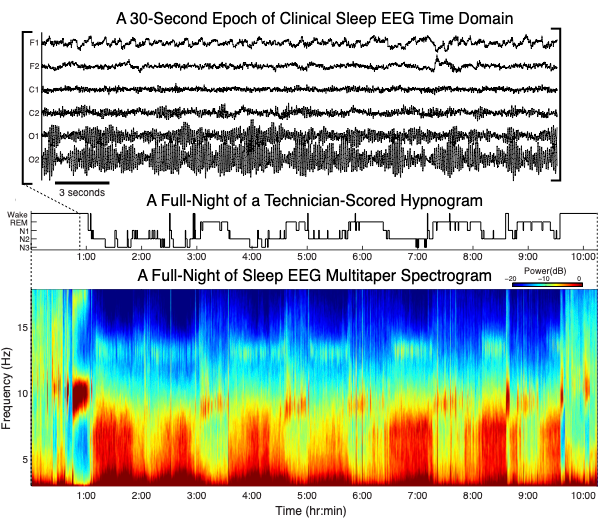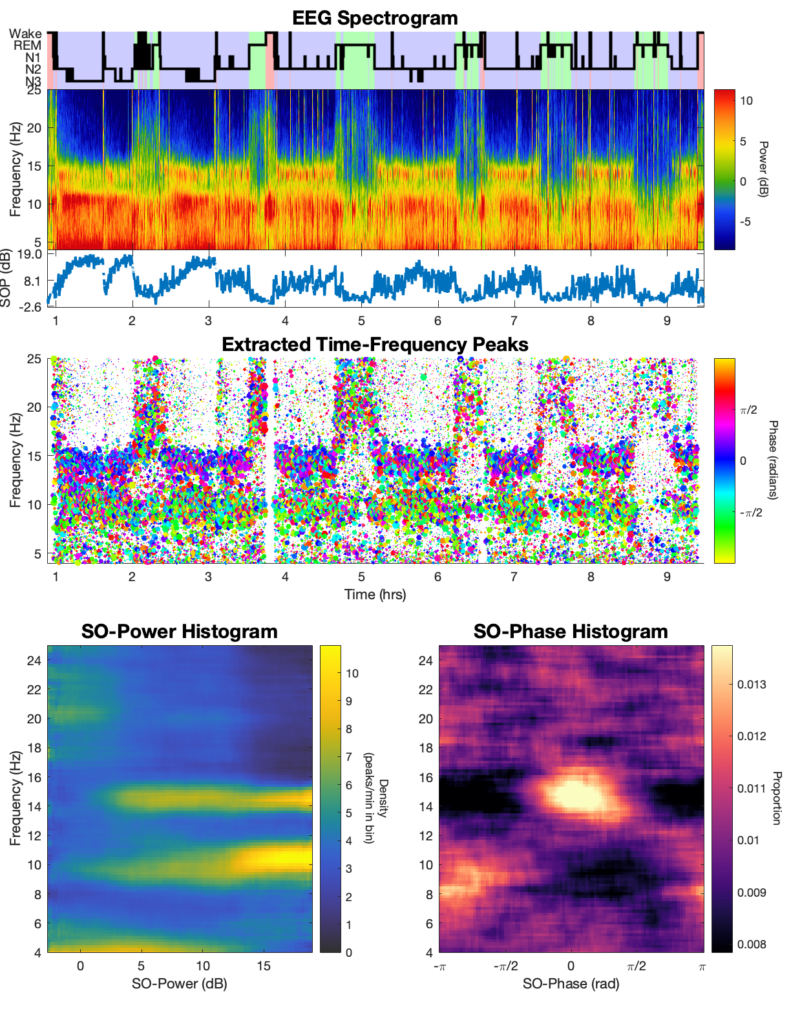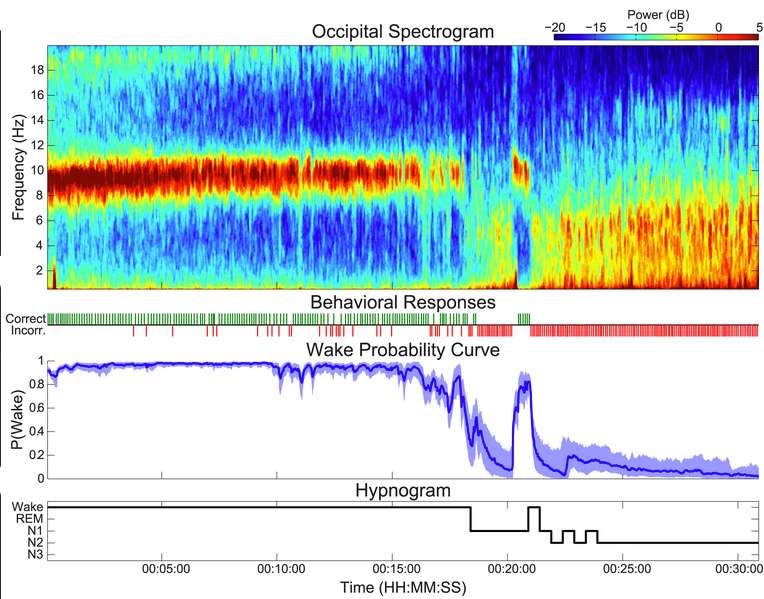Multitaper Spectral Analysis of Sleep EEG
In this set of tutorials, we will explain the theory of spectral analysis, an approach to breaking up a signal into individual oscillatory components at different frequencies.
We will then demonstrate how a technique called multitaper spectral analysis can create clear, vibrant pictures of brain dynamics during sleep — rich with information beyond what can be seen in traditional clinical hypnogram analyses.
Finally, we will show how to use multitaper spectral analysis clinically in order to visualize and score sleep from real polysomnograms. We also provide a spectral scoring manual, which gives guidelines on how to score different stages of sleep extremely quickly.
Transient Oscillation Dynamics – The DYNAM-O Toolbox
In this tutorial, we provide an overview on transient oscillatory events — short bursts of activity in the sleep EEG, and the DYNAM-O toolbox. Within sleep, perhaps the most well-known sleep EEG transient oscillation is the sleep spindle, which has been linked to memory consolidation, and changes spindle activity have been linked with natural aging as well as numerous psychiatric and neurodegenerative disorders. Our previous work has shown that traditional sleep spindles are just a subset of a larger class of events, which we term transient oscillatory events.
Transient oscillatory events will, by definition, appear as peaks in the time-frequency topography of the spectrogram, which we term time-frequency peaks or TF-peaks, for short. In this tutorial, we describe an approach for detecting TF-peaks in the EEG based on our work in Stokes et. al, 2022. This approach extracts TF-peaks by identifying salient peaks in the time-frequency topography of the spectrogram, using an image processing technique called the watershed algorithm.
We can then describe the dynamics of TF-peaks in terms of continuous sleep depth and cortical up/down states using representations called slow-oscillation (SO) power and phase histograms. These approaches provide powerful visualizations of tens of thousands of transient oscillatory events at all frequencies across the night, which are highly individualized and robust across nights, thus acting as potential “EEG fingerprints”.
We finally present the Dynamic Oscillation Toolbox (DYNAM-O) for MATLAB and Python. This package provides open source tools for TF-peak extraction as well for as the creation of the SO-power/phase histograms.
Sleep Apnea Dynamics

Obstructive sleep apnea (OSA), in which breathing is reduced or ceased during sleep, affects at least 10% of the population and is associated with numerous comorbidities. Current clinical diagnostic approaches characterize severity and treatment eligibility using the average respiratory event rate over total sleep time (apnea hypopnea index, or AHI). This approach, however, does not characterize the time-varying and dynamic properties of respiratory events that can change as a function of body position, sleep stage, and previous respiratory event activity.
In this tutorial, based on the paper from Chen et. al, we show a new approach that estimates an “instantaneous AHI”, which computes the moment-to-moment probability of a respiratory event as a function of changes in body position, sleep stage, and previous respiratory event activity. This model acts as a highly individualized respiratory signature, which can accurately predict the precise timing of future events and show robust differences in populations.
In this tutorial, we provide the corresponding codes to walk through people step by step, from model input construction to model fitting, model visualization, and model goodness-of-fit.
Tracking the Sleep Onset Process
How can we tell when someone has fallen asleep? Understanding the way we fall asleep is an important problem in sleep medicine, since sleep disorders can disrupt the process of falling asleep. In the case of insomnia, subjects may fall asleep too slowly, whereas during sleep deprivation or narcolepsy, subjects fall asleep too quickly. Current methods for tracking the wake/sleep transition are time-consuming, subjective, and simplify the sleep onset process in a way that severely limits the accuracy, power, and scope of any resulting clinical metrics. In this paper, we describe a new physiologically principled method that dynamically combines information from brainwaves, muscle activity, and a novel minimally-disruptive behavioral task, to automatically create a continuous dynamic characterization of a person’s state of wakefulness. We apply this method to a cohort of healthy subjects, successfully tracking the changes in wakefulness as the subjects fall asleep. This analysis reveals and statistically quantifies a subset of subjects who still respond to behavioral stimuli even though their brain would appear to be asleep by clinical measures. By developing an automated tool to precisely track the wake/sleep transition, we can better characterize and diagnose sleep disorders, and more precisely measure the effect of sleep medications.
In this video tutorial, we describe a new way of tracking the continuum of sleep onset, which incorporates EEG, physiological, and behavioral information to estimate the instantaneous probability that a subject is awake at each point in time.


